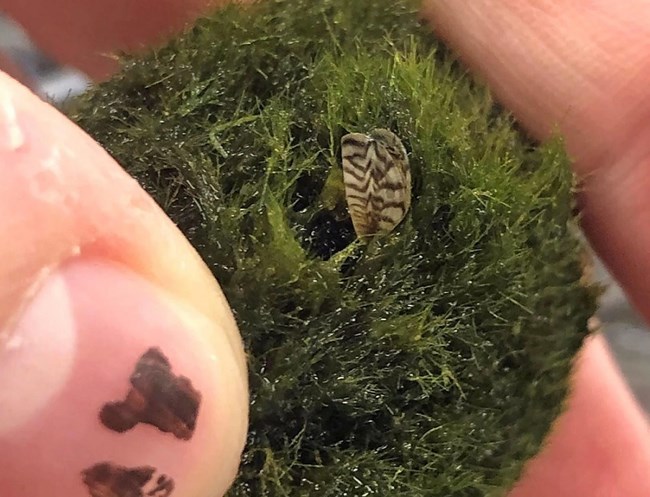
Photo courtesy of Oregon DFW
On March 1st, 2021, U.S. Geological Survey (USGS) scientists were alerted to the presence of zebra mussels, a species of freshwater mussel invasive to American waters, attached to or inside of moss balls sold at pet stores as aquarium plants. These moss balls, also known as marimo, are not actually a species of moss, but rather a species of green algae (Aegagropila linnaei) which is native to Northern Europe and Japan, and are popular as aquarium plants. As of March 12th, zebra mussels found on moss balls have been reported in more than 30 states across the U.S. The contaminated moss balls are thought to be coming from contaminated shipments from Ukraine, according to Wesley Daniel, a fisheries biologist with the USGS.
Zebra mussels are tiny, fingernail sized mollusks native to freshwater lakes in Eurasia. Although small in size, these invaders pose a massive threat to American freshwater ecosystems and have caused devastating ecological consequences to waters they’ve invaded, including the Great Lakes. Zebra mussels damage freshwater ecosystems by filtering nutrients and plankton out of the water and growing over native bottom dwelling species, which disrupts the food web and reduces the number of species able to thrive. Since zebra mussels multiply at a rapid rate and have no natural predators in the United States, they are quickly capable of spreading and overtaking lakes and rivers. These invaders have an economic impact too. Since zebra mussels prefer to cluster on hard surfaces, they are responsible for millions of dollars in damages every year to infrastructure such as water intakes and delivery systems, which constantly have to be maintained to prevent being clogged by the mollusks.
Contaminated moss balls have been found at large chain retailers as well as smaller independent and online retailers. Currently, the USGS is working with the U.S. Fish and Wildlife Service (USFWS) and pet stores to make sure that all moss ball stocks are removed from shelves, and about 30 percent of stocks removed have been found to be contaminated.
Anyone with moss balls should destroy and dispose of the plant, even if no zebra mussels are clearly visible. Aquarium owners should clean and decontaminate their tanks if they have contained a moss ball in recent months, as zebra mussels can threaten the health of a tank. The USFWS has developed guidelines on how to properly decontaminate and dispose of the moss balls, and are urging people to “destroy, don’t dump”. All precautions must be taken to ensure that zebra mussels are not released into the environment where they could contaminate previously uncontaminated water bodies.
To properly dispose of a moss ball, either:
• Place the moss ball into a sealable plastic bag and freeze for at least 24 hours
• Place the moss ball in boiling water for at least one minute
• Submerge the moss ball in regular, unscented bleach, diluted to 1/3 cup per gallon of water, for 10 minutes; or undiluted white vinegar for 20 minutes
Last updated: March 20, 2021
